Soccer according to Steve McCurry: a game that unites peoples in a brotherly embrace
When we think of soccer and photography, the image that is likely to appear first in our minds will be that of a great football champion caught in the highlights of an action that led to a decisive goal, a diving save, or hard contact with a player on the opposing team. Images, in short, from sports magazines, from in-depth television broadcasts of matches, from advertisements for which a footballer has been chosen as a testimonial. This, however, is not the soccer in which the great photographer Steve McCurry is interested. McCurry is, in essence, a traveler: he has traveled all over the world with his camera equipment, documenting customs and traditions of a vast number of countries and peoples. For him, therefore, soccer is not that of the big international matches, and it is not even, going down a level, that of the official matches of the minor leagues. For Steve McCurry, soccer is the very essence of soccer.
Therefore, any ancillary element cannot find a place in his art. The competitions, the cups, the rankings, the sponsors, the flawless athletic gestures, the televisions are surplus, because soccer is essentially a ball, an indefinite and uncoded number of players, and that lightheartedness necessary for any pastime. And since these three characteristics necessary to play soccer have universal validity, the first consequence is that, for Steve McCurry, soccer is essentially street soccer. It does not matter how many and which players there are, what age they are, what the ground is: all it takes is a ball and it is possible to have the monks of a Buddhist temple playing during a break from their meditations, a group of boys on the outskirts of a war-torn city, a cute little boy running alone with a ball through the alleys of his neighborhood. The second consequence will therefore appear obvious: the game of soccer, for the American artist, transcends every barrier, every nation, every language, to unite all the peoples of the Earth in a fraternal embrace, uniting the same cheerful faces in Cuba as in Ethiopia, in Russia as in Lebanon, in India as in Afghanistan. Steve McCurry has accustomed us to shots with an intense narrative flavor, and the Football and Icons exhibition that opened in Castelnuovo Magra (and will be on view until September 11) offers twenty-five shots that tell us twenty-five different stories, although the moral is always the same: soccer is a very powerful means of aggregation, which overcomes divisions. In short, soccer is positive passion and, like any positive passion, it is able to bring joy back to places where it had died out.
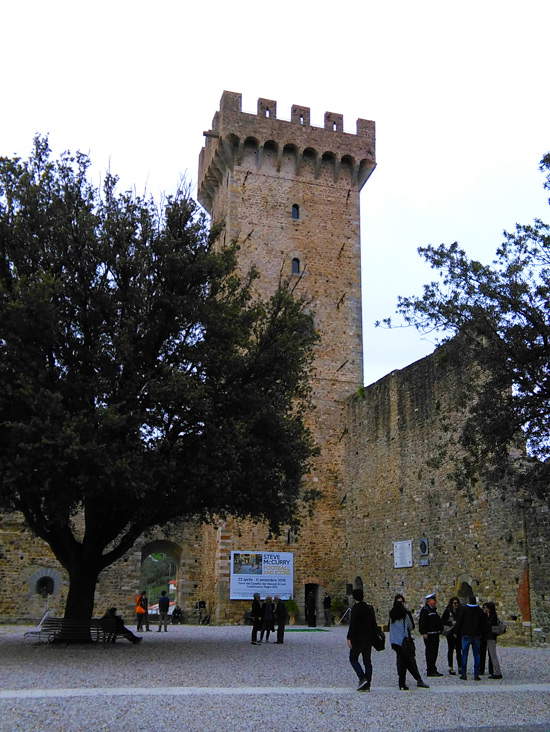 |
| The venue of the exhibition: the Tower of the Castle of the Bishops of Luni in Castelnuovo Magra |
The three essential characteristics of the game of soccer mentioned above are summed up in a shot that the exhibition’s curator, Biba Giacchetti, has strategically placed at the beginning of the exhibition itinerary, which unfolds along the six floors of the Tower of the Castle of the Bishops of Luni, in the historic center of Castelnuovo Magra. It is an image taken in 1998 in Morocco: a child, he will be five or six years old, enjoys kicking a ball in front of the characteristic blue gates of the ancient cities of the North African country. The photo, played on delicate tones, immediately arouses feelings of tenderness that manage to evoke the poetry of soccer and make us understand that barriers are but an invention of man (indeed: one of the ugliest and most unreasonable inventions of man), because the serene and carefree expression of a child manages to open hearts and, if only for a moment, to make us forget the empty and meaningless speeches of those who would like to foment discord. The photo is, moreover, a summary of what soccer should be: a ball, someone willing to kick it, and a smile. These are the three components, declined in various ways and found in every corner of the globe, that accompany the visitor along the exhibition. An exhibition, moreover, that is original: it is the first time ever that a thematic exhibition on soccer has been dedicated to Steve McCurry. We are therefore aware that we are moving through an unprecedented path. As unpublished and recent are, moreover, some of the photos on display.
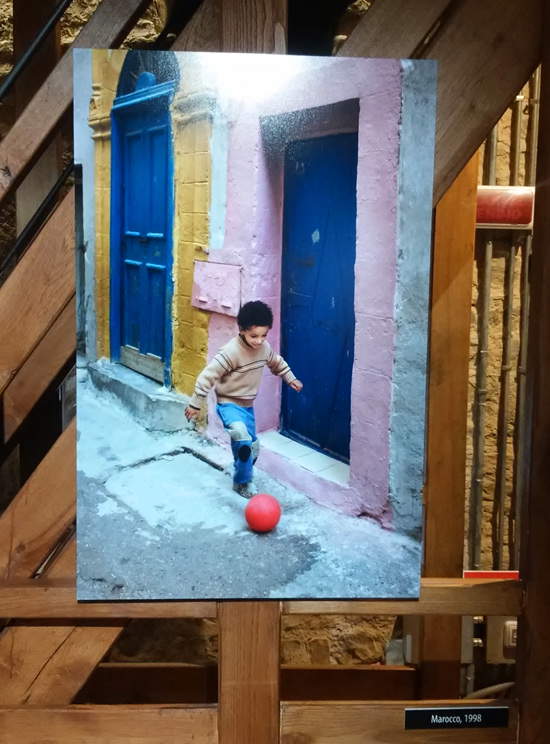 |
| Steve McCurry, Morocco, 1998 |
| Curator Biba Giacchetti presents the exhibition Football and Icons during the opening |
One of the latest shots depicts two young boys playing with a ball in Rybinsk, Russia. The photo is from a few weeks ago, dating back to December 2015: in the background, an airplane tells us about the industrial vocation of the city. In fact, it is a monument erected during the years of the Soviet Union (in 1983, to be exact) to pay tribute to the workers of the nearby factories where aircraft engines and components were, and still are, built. The diagonal cut chosen for the shot echoes the lines, also diagonal, of the monument’s base. The playing field here is probably what remains of the courtyard of a building. And a “makeshift” field is also the one, most peculiar, depicted in a 2014 photograph whose protagonists are some very young shepherds of the Amara ethnic group chasing a ball downhill, among their cows, on the slope that, in this patch of Ethiopia, from pasture becomes momentarily a playing field. The field, in Steve McCurry’s photographs, is almost always uncomfortable: not just a barren backyard or a slope, but also a muddy meadow on which a child tumbles in a 1983 image captured in Bangladesh, or the concrete leading toward the entrance to a monastery in Burma. And it is worth noting that the protagonists in Steve McCurry’s soccer-themed images are not just children or young boys: a photograph taken in 2003 in Herat, Afghanistan, shows us a group of men playing under the Bala Hisar Fort. An attempt to return normalcy to places wracked by the brutality of a bloody regime and grueling wars.
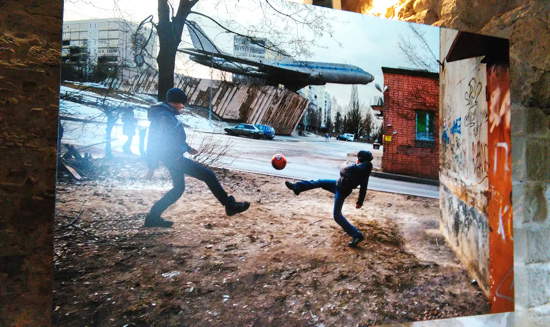 |
| Steve McCurry, Rybinsk (Russia), 2015 |
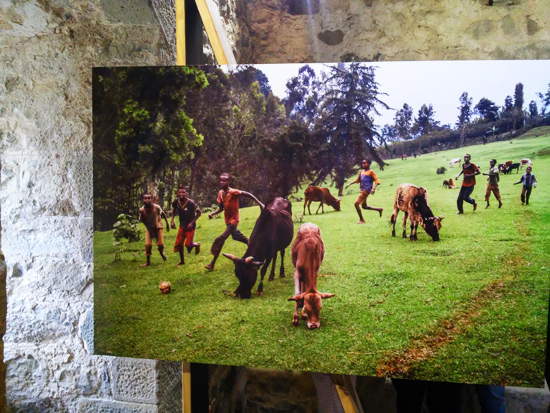 |
| Steve McCurry, Amara Region (Ethiopia), 2014 |
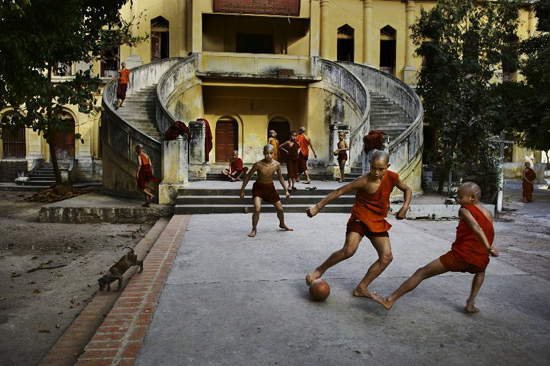 |
| Steve McCurry, Burma, 2010 |
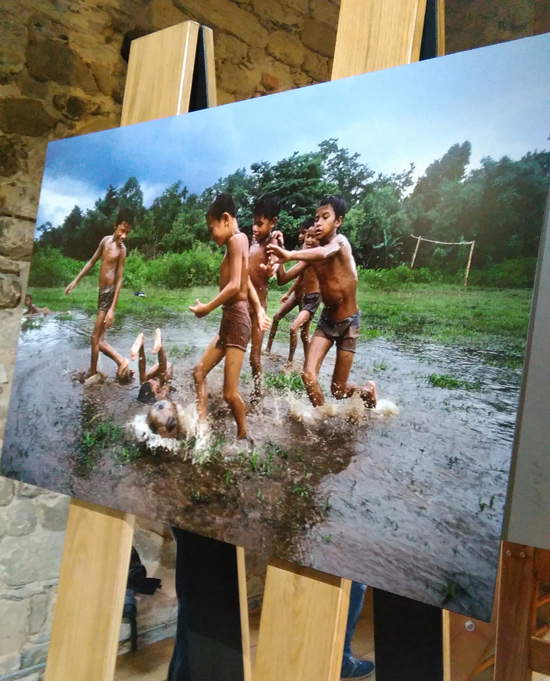 |
| Steve McCurry, Sylhet (Bangladesh), 1983 |
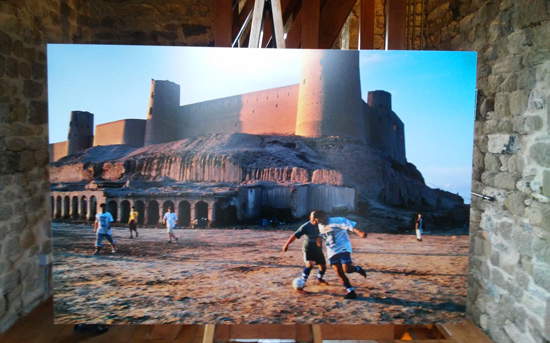 |
| Steve McCurry, Bala Hisar Fort, Herat (Afghanistan), 2003 |
In his blog, Steve McCurry, introducing some of his work on street soccer, quotes a quote from Scottish footballer Bill Shankly, as a flagship player for Preston North End, and as a legendary coach of Liverpool, which, under his management, won three domestic championships, two FA Cups, and a UEFA Cup: “Some people think soccer is a matter of life and death. But I can guarantee that it is a much more important matter.” To understand this statement, one must necessarily dwell on a pair of images that could almost be elected the exhibition’s photo-symbol. They both date from 1982 and both were taken in a Beirut destroyed by the bombing of the war that took the lives of nearly twenty thousand civilians that year. And they are two photographs that show us how much the power of play and cheerfulness can overpower the violence of war. In the first shot, we witness an impromptu game between some children playing near the rubble, in front of the buildings gutted by the explosions. It is a highly symbolic photo: the buildings, once colorful, and now reduced to a row of mute gray skeletons, stand in the background. In the foreground, children, wearing clothes of all colors, kick a ball around. A message that sounds almost like an invitation, and at the same time like hope: to leave destruction behind and try to make life flourish again. A message that starts from one place (and the flag in the background takes on just the connotation of geographic clarification) but spreads all over the world. And that is complemented by the second photograph: some children play clinging to the carcass of an anti-tank gun, under the eye of a mother. The ball cannot be seen, but the absence does not detract from the meaning of the painting: just as in Sandro Botticelli ’s Venus with Mars the Cupids of Venus succeeded in putting Mars to sleep, becoming a symbol of love winning over war, in the same way McCurry’s children allegorically represent play, carefreeness, and the desire for the future that prevail over violence.
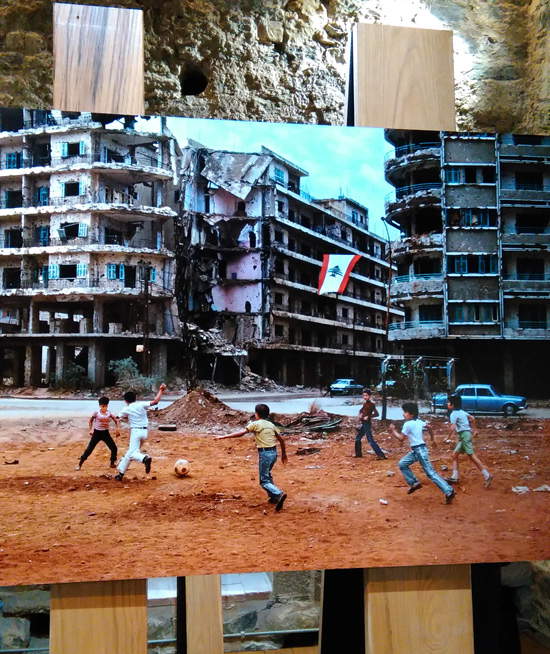 |
| Steve McCurry, Beirut (Lebanon), 1982 |
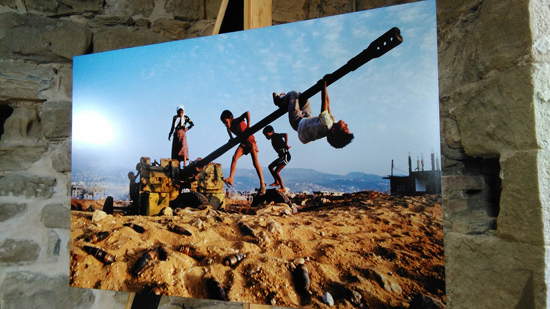 |
| Steve McCurry, Beirut (Lebanon), 1982 |
During the presentation of the exhibition, the mayor of Castelnuovo Magra, Daniele Montebello, recalled his meeting with Steve McCurry a year ago, which took place to finalize the details of the lectio magistralis the photographer gave in the Ligurian village last summer. McCurry was in Milan and, talking about soccer, noted how in the big metropolises the taste for playing soccer in the streets had been somewhat lost (and he was particularly displeased by the fact that, when he was in college, he himself had played soccer). Montebello retorted by saying that in Castelnuovo there is still a square where children play soccer: it is the square in front of the Castle of the Bishops of Luni. In fact, looking out of a small window from the top of the Tower inside which the exhibition is being held, we noticed just such a small group of children who, with the joy and carefreeness that characterizes them, were playing with a ball: they were running and passing the ball happily to each other, with the same smile that Steve McCurry immortalized on the faces of the children protagonists of his shots. Here is the message of aggregation, of unity among people kicking a ball outside the usual soccer fields is revealed before our eyes: in McCurry’s extraordinary photographs and in the square below the Tower of the Castle of the Bishops of Luni, as in any other place in the world.
| Steve McCurry. Football and Icons, Tower of the Castle of the Bishops of Luni, Castelnuovo Magra, April 22, 2016 through Sept. 11, 2016. |
Warning: the translation into English of the original Italian article was created using automatic tools. We undertake to review all articles, but we do not guarantee the total absence of inaccuracies in the translation due to the program. You can find the original by clicking on the ITA button. If you find any mistake,please contact us.





























